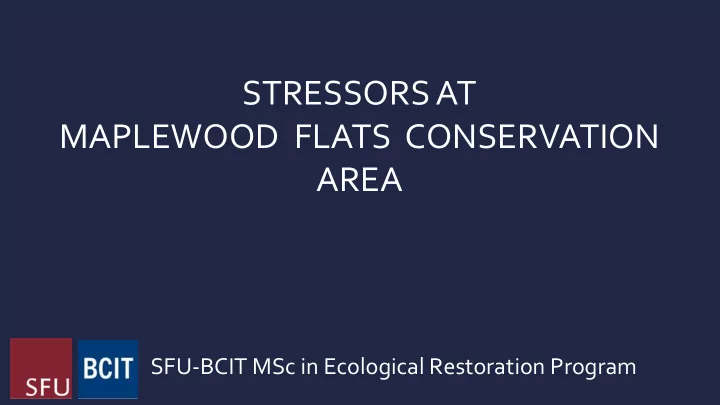

STRESSORS AT MAPLEWOOD FLATS CONSERVATION AREA SFU-BCIT MSc in Ecological Restoration Program
Maplewood Flats Traditional territory of Tsleil-Waututh Nation Land owned by the Port of Vancouver and the District of North Vancouver Managed by the Wild Bird Trust
Site Stressors • plant community composition • altered landscape connectivity • increasing public use • climate change effecting temperature, precipitation
Non indigenous species
Results of plant survey: frequency Table 1: Ten most frequent species found sample quadrats (NIS species identified with star ).
Plant survey results: plant diversity and % cover Mean results of species count and percent cover, upland landscape DNV East Category VFPA (n=40) Reference (n=6) (n=27) Species count (mean) 12.5 (SD= 5) 14.5 (SD = 4) 14.2 (SD= 4.6) Indigenous species 6.1 (SD= 2.6) 10.1 (SD= 3.6) 9.7 (SD= 2) Indigenous shrub species 1.8 (SD=1.4 ) 4 (SD= 1.8) 3.8 (SD= 0.8) Indigenous shrub (% Cover) 20% (SD=25% ) 48% (SD= 29%) 85% (SD= 17% ) R. armeniacus (% Cover) 51% (SD=36% ) 9% (SD=16% ) 3% (SD=4% ) H. helix (% Cover) 5% (SD=15% ) 51% (SD=37% ) 5% (SD=10% )
Plant diversity/structural complexity decreases as invasive species cover increases High HH, low cover High R.A., low diversity High diversity, high cover
Native Plant Composition • Bleeding heart : 3 of 70 sites • False Lily of the valley: 7 of 70 sites • Piggy-back plant: 4 of 70 sites • Red huckleberry: 8 0f 70 sites • Salal found on 4 of 70 sites • Not found: • Foam flower, Queen’s cup, twisted stalk, False Solomon’s seal, goatsbeard, honeysuckle….
Altered connectivity, fragmentation 1990 ~1942 1969 J.S. Matthews Vancouver Archives Province of BC. Selkirk Remote Sensing 2016 Google earth 2016
DNV Planned Development Google earth 2017
Effects of increased public use • Impacts on Infrastructure • Wildlife Disturbance Interrupts feeding (Belanger and Bedard 1989) - snow geese disturbed ≥2 per hour = 50% fewer the next day Dogs disturb birds (Banks and Bryant 2007) -lumans alone = 20% reduction in birds -leashed dog on trail = 40% reduction -birds not habituated
Increased Public Use Positive Impacts -higher profile for site -educational opportunities -reconciliation opportunities -potential increased funding from land owners -upgrades to infrastructure
Climate Change: • Wetter winters and springs, hotter drier summers • sea level rise • ocean acidification • effects on mudflats • effects on plants • effects on wildlife
Stress to mudflats • climate Change: ocean acidification • calcium based shells: bivalves, mollusks, crustaceans (prawns, crabs), isopods, (gribbles), ship worms are harmed by ocean acidification • sewage, nutrients, acid rain (from refineries and car exhaust) lower pH • shore birds, waterfowl, herons, wildlife forage on the mud flats
Climate Change: Sea level rise https://seeing.climatecentral.org
Recommend
More recommend